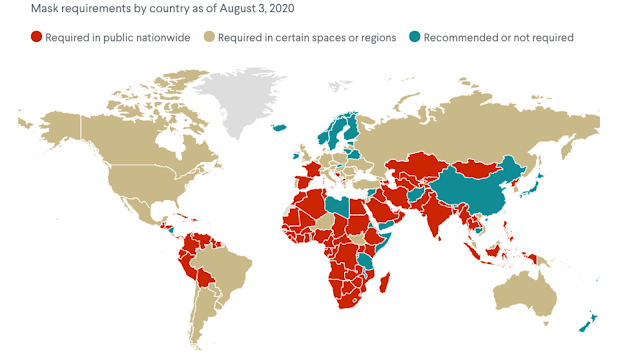The science of masking
While institutions like the CDC keep insisting that the people should believe in ‘the science’, anyone remotely familiar with the discipline knows that there is no ‘the science’. In fact, as Einstein said, “The important thing is not to stop questioning.” This is especially true if you followed Dr Anthony ‘The Science’ Fauci, and realise that ‘the science’ can do abrupt U-turns with dubious motives.
Take face masks, which has
been mandated
across the world as a sine qua non against the COVID pandemic.
One cannot help noticing a lack of evidence presented for the usefulness of
masks against the SARS-CoV-2 virus to back up this global muzzling.
The CDC did publish a mask mandate study in February of 2021, which suggested a correlation between mask mandates and drops in COVID cases in the US. However, the study is deeply flawed, requiring an erratum just a fortnight after the initial publication. Furthermore, the underpinning assumption of the study is that masks protect against viral infections. But does it?
Well, not according to the CDC’s own
publication in May of
2020. The review on nonpharmaceutical measures against pandemic influenza stated
that:
“[E]vidence from 14
randomized controlled trials of [hand hygiene and face masks] did not support a
substantial effect on transmission of laboratory-confirmed influenza.”
The WHO’s
2019 document on
nonpharmaceutical public health measures in pandemics likewise concluded that,
regarding transmission of influenza:
“Although there is no
evidence that [wearing face masks] is effective in reducing transmission, there
is mechanistic plausibility for the potential effectiveness of this measure.”
The American Medical
Association, writing in the journal JAMA
in March 2020, stated:
“Face masks should not be
worn by healthy individuals to protect themselves from acquiring respiratory
infection because there is no evidence to suggest that face masks worn by
healthy individuals are effective in preventing people from becoming ill.”
All this is not surprising,
given that most people probably do not wear them effectively in the first
place. But what about mask wearing in medical workers?
A well-cited
2015 study conducted a
randomised trial comparing cloth masks and medical masks in 1,607 hospital
health workers on their ability to prevent respiratory viral infections. The
authors found, to their surprise, that those wearing cloth masks at all times had
significantly higher risks of infections (13 times the risk) than those wearing
medical masks, despite similar levels of mask compliance. More surprisingly,
those wearing cloth masks had significantly higher
risks of infection than even those in the control group, who may or may not have worn masks
during their shifts based on usual practice, and who had much lower mask
compliance. On the other hand, the rates of illness between the control group
and those wearing medical masks were comparable. The authors suggested that moisture
retention in the cloth masks, as well as lack of cleaning, allow viruses to
survive in them, which promote self-contamination through people touching the
masks and then the eyes or mouth.
Hence medical masks may not
be doing much good, even in health professionals, whereas cloth masks, which is
favoured by many for its relative comfort, may be increasing the risk of
infections.
This finding is corroborated
by a recent
study conducted in
Bangladesh, examining the effect of masks in preventing COVID across 600
villages and involving more than 342,000 adults. The study found that cloth
masks did not reduce the risk of COVID at all compared to villages where masks
were not promoted, and that medical masks had a marginal effect, reducing
infections by 11%. Of note, masks were distributed to the villagers for free
and frequently, and the cloth masks used were of better quality than most cloth
masks available, with three layers, including an outer layer of 100% non-woven
polypropylene, and a nose bridge.

Masks are provided free and frequently, with strong promotion and reinforcement in the study
These studies suggest that, at best, the benefit of masking is minimal, and at worst, cloth masks in particular may be harmful. But masking comes with other costs. A 2020 German study found that medical masks significantly reduced ventilation. It can also result in increased blood CO2 level, which can cause a host of problems such as exhaustion, reduced cognitive performance, intensified psychiatric issues, and gynecological risks among others. Masks also pose the risk of inhaling microplastic debris, which can lead to lung disease.
A study
in Germany reflected
some of the negative effects of masking in children, who reported difficulty
concentrating, irritability, headaches and other malaise. In particular, masks
are being mandated for children as
young as two in places
such as New York. But look at the data - the risk of death or even serious illness from
COVID extremely
low in children. In Sweden,
where masks were never mandated, and where preschools and schools remained
open, a
study looking at over 1.9
million children from the ages of 1–16 found that not a single child died from
COVID, including two children with cancer who contracted the virus.
While no one should be stopped from wearing a mask if they so choose, the data does not remotely suggest a mandate is warranted. Indeed, particularly in children, masks may do much more harm than good. So how is it scientific for the establishment and its media advocates to be banning law makers like Dr Rand Paul, a US member of congress, from posting videos advocating against masking of children? It seems that ‘the science’ is not only not following science, it is actively denying the scientific process.






This comment has been removed by a blog administrator.
ReplyDelete